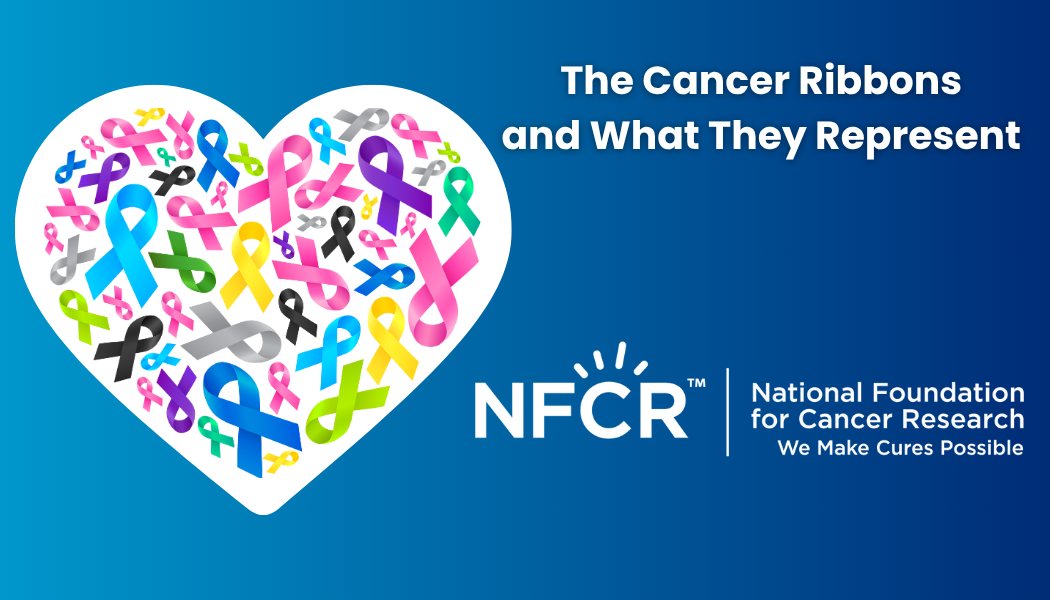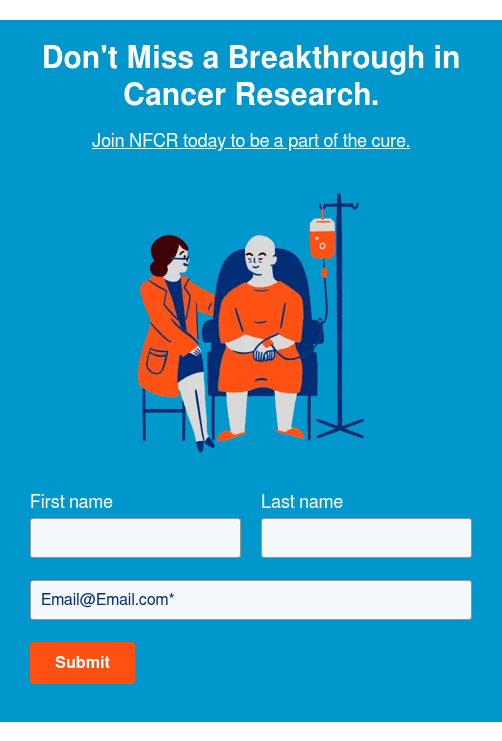Cancer Ribbon Colors and What They Represent

Awareness ribbons are powerful symbols in the fight against cancer. Each color represents a specific type of cancer and helps raise awareness, honor patients and survivors, and inspire action to support research.
While the pink ribbon for breast cancer is the most recognizable, there are dozens of ribbons that represent different cancer types. Wearing or sharing these ribbons is a simple yet meaningful way to show support, raise awareness, and encourage early detection.
At the National Foundation for Cancer Research (NFCR), we know that awareness drives action, and action drives breakthroughs. Below is a guide to the most widely recognized cancer ribbon colors, the cancers they represent, and the months dedicated to raising awareness.
Pink – Breast Cancer
- Awareness Month: October
- The pink ribbon has become a universal symbol of breast cancer awareness, representing hope, strength, and the importance of early detection.
- Variations include:
- Pink and Blue: Male breast cancer
- Pink, Teal, and Green: Metastatic breast cancer
- Hot Pink: Inflammatory breast cancer
Gold – Childhood Cancer
- Awareness Month: September
Gold symbolizes how precious children are. This ribbon represents all forms of pediatric cancer and the urgent need for research to save young lives.
Gray – Brain Cancer
- Awareness Month: May
- Gray represents the brain’s “gray matter.” This ribbon brings awareness to both malignant brain cancers and noncancerous tumors that can still impact health and quality of life.
Orange – Leukemia & Kidney Cancer
- Leukemia Awareness Month: September
- Kidney Cancer Awareness Month: March
- Orange ribbons represent two different cancer types: leukemia, a blood cancer affecting bone marrow and white blood cells, and kidney cancer.
Red – Blood Cancer
- Awareness Month: September
- The red ribbon represents blood cancers broadly, including:
- Leukemia (Orange)
- Hodgkin Lymphoma (Violet)
- Non-Hodgkin Lymphoma (Lime Green)
- Multiple Myeloma (Burgundy)
Burgundy – Multiple Myeloma
- Awareness Month: March
- This deep burgundy ribbon raises awareness for multiple myeloma, a cancer of the plasma cells in bone marrow.
Violet – Hodgkin Lymphoma
- Awareness Month: September
- Violet ribbons are used to represent Hodgkin lymphoma, a highly treatable type of blood cancer that begins in the lymphatic system.
Lime Green – Non-Hodgkin Lymphoma
- Awareness Month: September
- Lime green ribbons raise awareness for non-Hodgkin lymphoma, which impacts the immune system through abnormal lymphocyte growth.
Light Blue – Prostate Cancer
- Awareness Month: September
- Light blue ribbons are used for prostate cancer, one of the most common cancers in men. Early detection through screening can be life-saving.
Dark Blue – Colorectal Cancer
- Awareness Month: March
- Dark blue ribbons represent colorectal cancer, which affects the colon or rectum. Awareness efforts encourage regular screenings like colonoscopies for early detection.
Yellow – Sarcoma & Bone Cancer
- Awareness Month: July
- Yellow ribbons symbolize sarcomas, a group of cancers that develop in bones or connective tissues, as well as primary bone cancers.
Black – Skin Cancer / Melanoma
- Awareness Month: May
- Black ribbons are used to raise awareness of melanoma and other forms of skin cancer, encouraging sun safety and early detection through skin checks.
Pearl or White – Lung Cancer
- Awareness Month: November
- Pearl or white ribbons symbolize lung cancer awareness. This type of cancer is the second most common in the U.S. and is responsible for a significant portion of cancer-related deaths.
Purple – Pancreatic Cancer
- Awareness Month: November
- Purple ribbons are widely recognized for pancreatic cancer, a disease that is challenging to detect early. The ribbon is a symbol of hope and advocacy for improved treatments.
Teal – Ovarian Cancer
- Awareness Month: September
- Teal ribbons bring attention to ovarian cancer, a disease often diagnosed at a later stage due to subtle symptoms.
White and Teal – Cervical Cancer
- Awareness Month: January
- This two-toned ribbon represents cervical cancer. Early detection through regular screenings, like Pap tests and HPV tests, has significantly improved outcomes.
Peach – Uterine / Endometrial Cancer
- Awareness Month: September
- Peach ribbons raise awareness for cancers of the uterus, including endometrial cancer.
Amber – Appendix Cancer
- Awareness Month: August
- Amber ribbons represent rare appendix cancers. Awareness helps promote research for less common cancers that receive limited attention.
Emerald Green – Liver Cancer
- Awareness Month: October
- Emerald green ribbons symbolize liver cancer awareness. Liver cancer often develops in those with chronic liver disease or hepatitis.
Light Purple – Testicular Cancer
- Awareness Month: April
- Light purple ribbons bring awareness to testicular cancer, which is most common in men ages 15–44.
Zebra Print – Carcinoid & Neuroendocrine Tumors
- Awareness Month: November
- Zebra-striped ribbons are used for carcinoid cancers and neuroendocrine tumors, highlighting the rarity and complexity of these cancers.
Lavender – All Cancers
- Awareness Month: February (National Cancer Prevention Month)
- Lavender ribbons represent all cancers collectively. Wearing or displaying this ribbon shows support for everyone touched by cancer.
Why Cancer Ribbons Matter
Awareness ribbons are more than just symbols. They:
- Honor the journeys of patients and survivors
- Encourage early detection and preventive screenings
- Inspire support for lifesaving cancer research
At NFCR, we believe that knowledge fuels action. By understanding these ribbons and the stories they carry, you join a global movement to advance research and bring us closer to cures.
Take Action Today:
- Support Cancer Research
- Learn More About Cancer Types
- Share this blog to spread awareness
Together, we can transform awareness into breakthroughs.





















Sign-up to Stay Informed About Cancer Research Breakthroughs with NFCR!
[vc_template name=”A world without”]
A world without cancer is possible. Help us turn lab breakthroughs into life-saving realities.

5.7 Million+
Donors who have fueled NFCR’s mission

$420 Million+
Invested in high-impact research & programs

36+ Labs & Hundreds of
Nobel Laureates & Key Scientists received NFCR funding, driving breakthrough research











